Are you looking for an easy way to use Google Analytics 4 event tracking for your WordPress site? You’re in the right place!
Tracking events on your website, like button clicks, form submissions, or even video views, is very important. It helps you understand what your visitors are doing and what they like.
But if you’re thinking, “That sounds complicated,” don’t worry! It’s easier than you think, especially with WordPress.
This guide will walk you through setting up Google Analytics event tracking on your WordPress site—no need for complex code or confusing setups. We’ll show you a straightforward way to monitor your visitors’ important actions, helping you make smarter decisions for your website.
Whether you’re curious about which links your visitors click the most, which pages they love, or how they interact with your content, we’ve got you covered. Let’s dive in!
- What Is Google Analytics 4 Event Tracking?
- The Benefits of Setting up GA4 Event Tracking
- How to Set Up GA4 Event Tracking in WordPress
- How to Track Events in Google Analytics 4
- Understanding Event Parameters and Automatic Tracking in GA4
- Frequently Asked Questions
What Is Google Analytics 4 Event Tracking?
Before we dive into the how-tos, let’s first understand what Google Analytics 4 (GA4) event tracking is.
Think of GA4 as a super-smart helper that watches what happens on your website. It’s like having a friend who tells you every interesting thing people do on your site!
In GA4, ‘events’ are the actions or details you want to monitor. For instance:
- Pages your visitors view: when someone checks out your blog post.
- Actions they take within a page: like filling out a form.
- Buttons or links they click on: for example, that ‘Buy Now’ button.
- Details about products they look at or buy
- Information you know about your user: if they’re a first-time visitor or a returning one.
You can track many different events and reports you can make with GA4. You get to decide what events to track based on what’s essential for your business and what kind of reports you want to create.
The Benefits of Setting up GA4 Event Tracking
Setting up Google Analytics event tracking on your WordPress site is like having a clear vision of your site. It gives you extra valuable insights into what’s happening and what actions your visitors are taking.
Here are some key benefits:
- Track What Matters to You: With GA4, you can keep an eye on almost anything you’re curious about on your site.
- Quick Responses: GA4 event tracking gives you a good view in case something is not working or declining. It lets you react swiftly to fix things or make improvements.
- Measure Success: Find out how well your site’s interactive elements work. GA4 event tracking shows you valuable insights like if your forms bring in leads or visitors watch your videos.
- Understand Your Audience: Learn what your visitors like. Which pages are they spending time on? What products are they interested in? This helps you do more of what works.
- Boost Sales: Knowing what your audience likes lets you fine-tune your site to boost sales and conversions.
- Engagement Insights: Discover how engaged your visitors are. Know if they’re reading your blogs, downloading your ebooks, or using your tools. This info is invaluable!
Adding GA4 event tracking to your WordPress site is like giving yourself a superpower to understand and improve your website’s performance. It’s all about making informed decisions to grow your site and create engaging content for your audience.
How to Set Up GA4 Event Tracking in WordPress
Setting up event tracking may require assistance from a professional or a developer unless you’re using WordPress.
WordPress users can use ExactMetrics to track their events with ease.
Setting up GA4 event tracking in WordPress is a breeze when you use ExactMetrics. It’s the best premium Google Analytics plugin out there, designed to make your life easier and your website smarter.
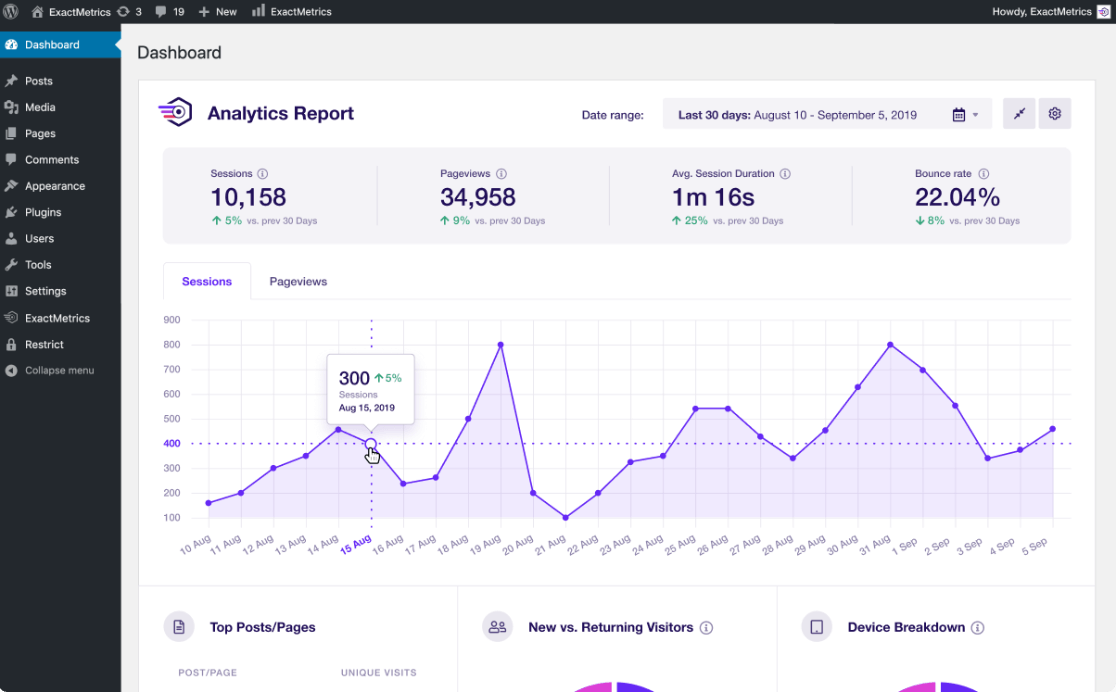
Why Choose ExactMetrics?
Think of ExactMetrics as your friendly analytics helper. It’s packed with features that make tracking a walk in the park:
- Simple, Code-Free Setup: Say goodbye to the headache of coding. ExactMetrics lets you integrate Google Analytics with your WordPress site without touching a single line of code.
- User-Friendly, Right in WordPress: No need to juggle between different tools. ExactMetrics brings detailed Google Analytics reports directly to your WordPress dashboard.
- Powerful Tracking at Your Fingertips: From advanced tracking options to user-friendly reports, everything is just a few clicks away.
Additionally, with just a few clicks, you unlock a range of extra Google Analytics features and sophisticated tracking options. Here’s a glimpse at some of the most popular features:
- E-commerce Tracking: Keep an eye on your online store’s performance, from sales to customer behavior, without complexity.
- Link and Button Click Tracking: Discover which outbound and affiliate links are your visitor’s favorites.
- GDPR Compliance Hassle-Free: Stay on top of legal requirements.
- Form Tracking: Understand how your forms are performing.
- Social Media Insights: Get a clear view of your content’s performance across different social platforms.
- Highlight Your Best Content: Automatically showcase your most popular posts or products to your visitors.
With ExactMetrics, diving into the world of Google Analytics 4 is like stepping into a well-organized room where you find everything you need. It simplifies the complex, making your WordPress site smarter and more in tune with your audience.
To start, go to the pricing page and get the license level that works for you.
Then, download the plugin and upload it to your WordPress site.
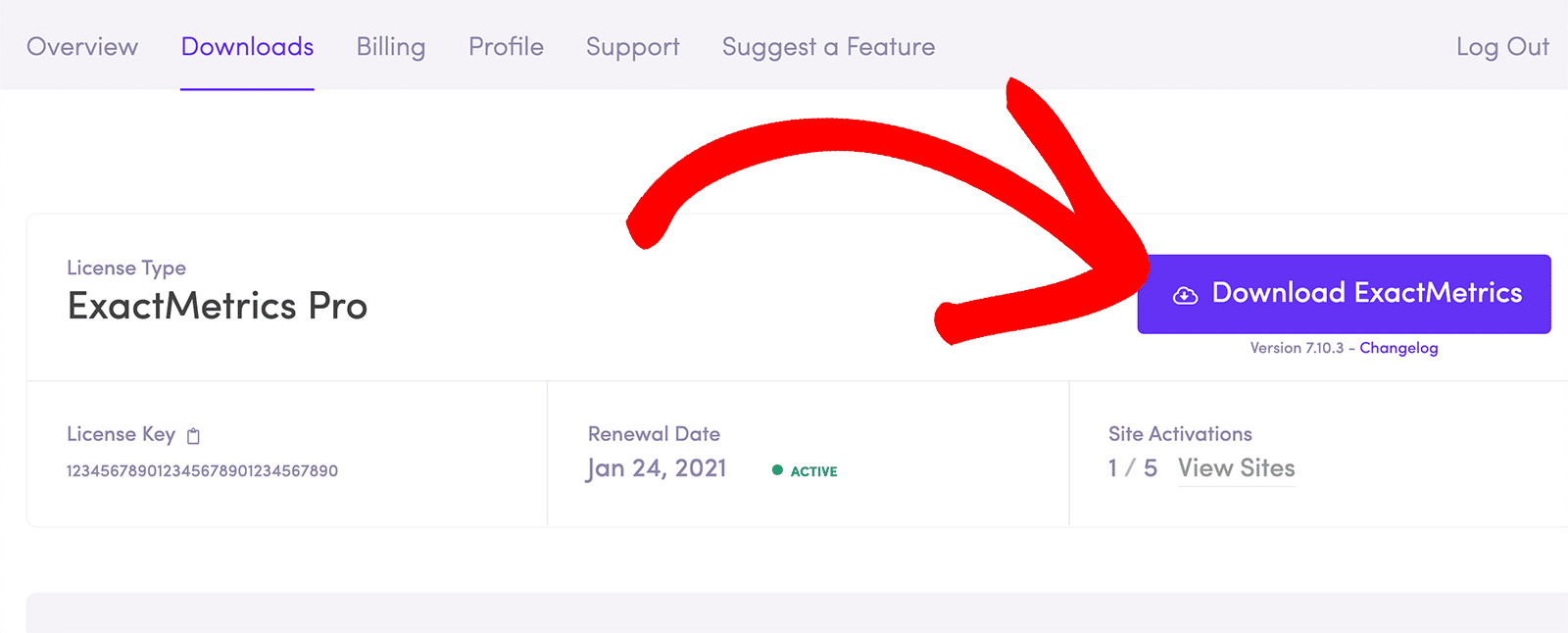
Once you’ve installed and activated ExactMetrics, begin the setup process using the setup wizard to link your Google Analytics account with ExactMetrics.
Check out How to Add Google Analytics to WordPress for step-by-step instructions.
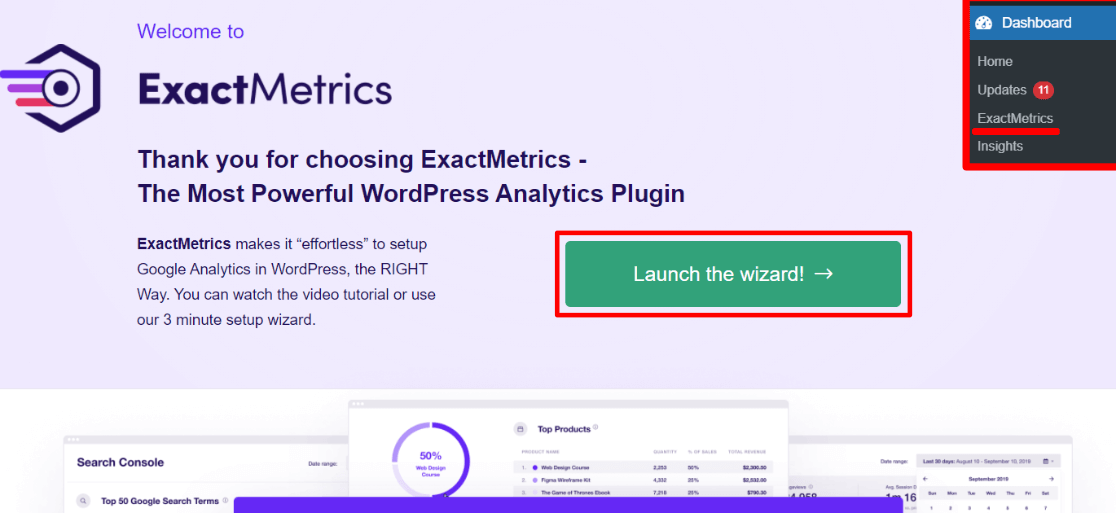
Now that the plugin is connected with Google Analytics and your site let’s look at how to track a whole list of events quickly and easily with ExactMetrics.
Track Outbound Links
It is beneficial to track outbound links for several reasons. First, it allows you to track what interests your audience the most and create content for your website that meets those needs.
For instance, suppose there’s a link on your site to a particular book you often recommend, but you’re not enrolled in any related affiliate program. If this link is frequently clicked, it might be a signal to explore potential affiliate opportunities with book retailers or publishers.
Or, let’s say you have a link to a groundbreaking research study relevant to your niche. Creating an in-depth article or a series of posts around this topic could be a good idea if this link gets significant attention.
Tracking outbound links with ExactMetrics is exceptionally easy. All you have to do is download and install the plugin, and ExactMetrics will work its magic and automatically track your outbound links.
To find the report, head to your WordPress dashboard » ExactMetrics » Reports » Publishers » Overview.
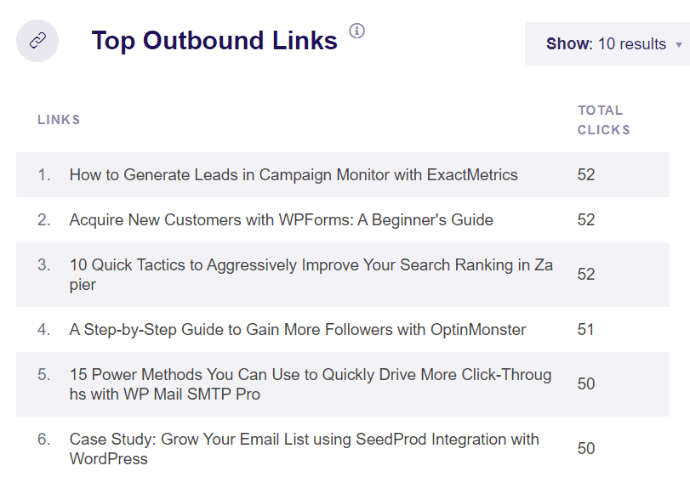
For more information, check out How to Track Outbound Links in Google Analytics (Simple Way).
Track Form Submit Buttons
Discover how many visitors are filling out your forms with ease in the ExactMetrics dashboard.
To use this feature, download the Pro version of ExactMetrics. After that, install the Forms addon. This will enable automatic tracking of your form submissions in Google Analytics.
Additionally, you’ll gain insights into the number of views and the conversion rate for each form directly within your WordPress dashboard. This allows you to effortlessly evaluate how effective they are.
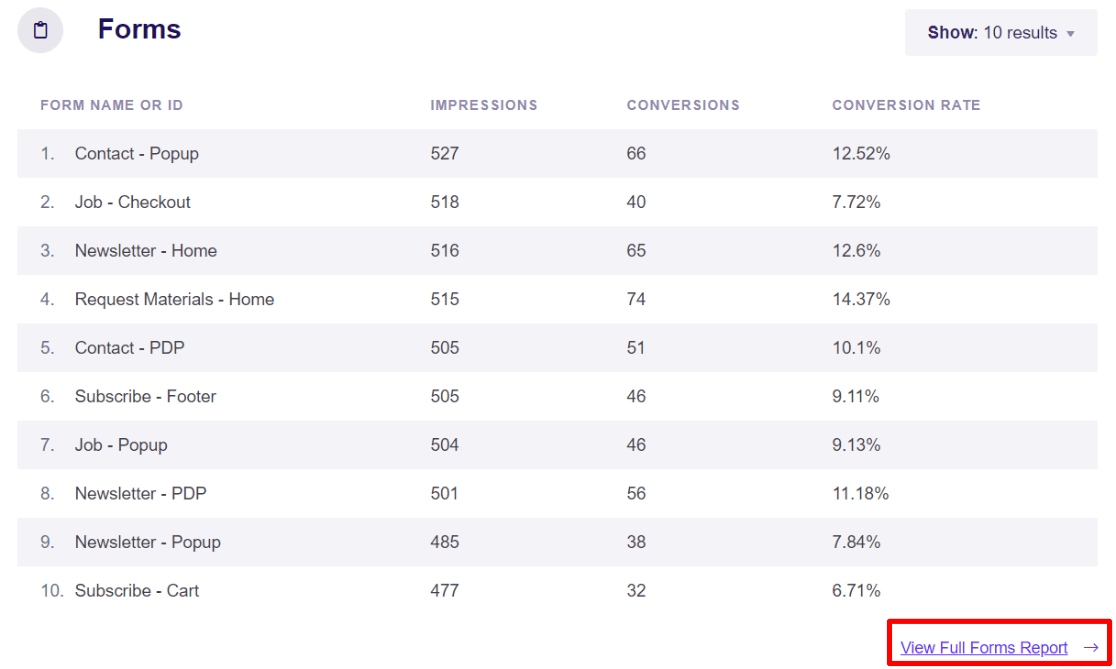
To read a full tutorial on form conversion tracking, see How to Track Form Submissions in Google Analytics (Easy Way).
Track Add to Cart Button Links
For those managing an eCommerce store, tracking shopping behavior is crucial. One key aspect is monitoring how often items are added to the shopping cart or abandoned.
Users of ExactMetrics Pro benefit from a one-click setup for eCommerce tracking in Google Analytics and WordPress. Plus, they can access comprehensive eCommerce reports in their WordPress dashboard.
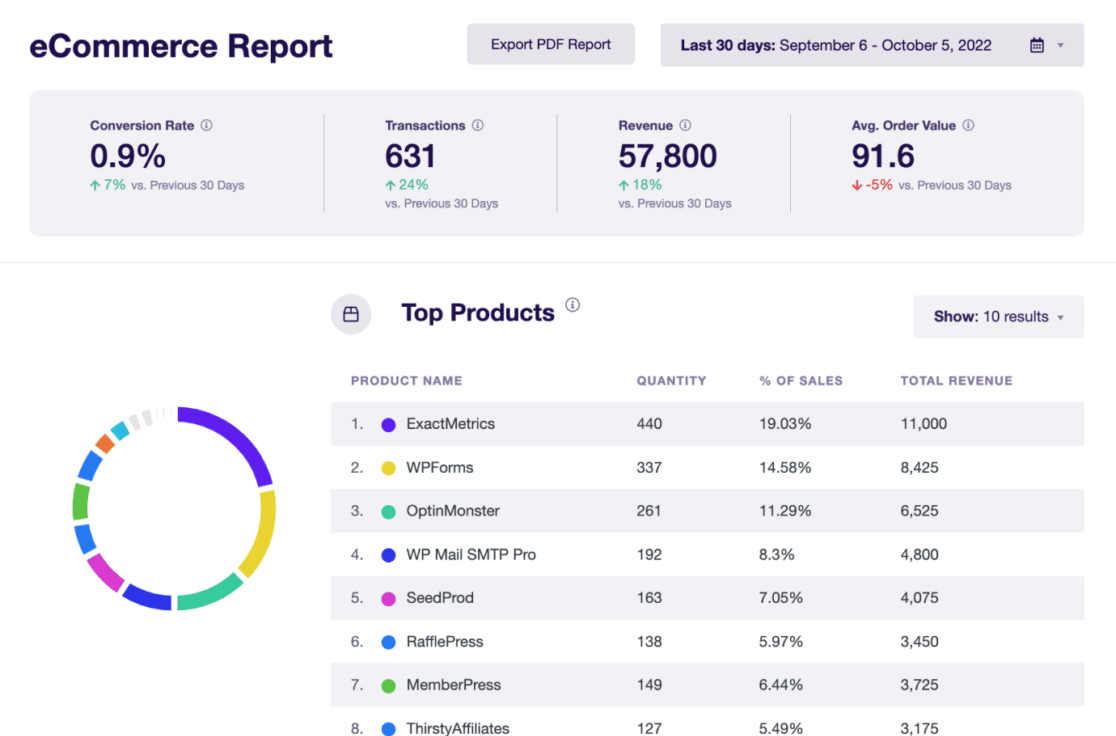
Additionally, ExactMetrics automatically monitors ‘add to cart’ actions. Once you have eCommerce tracking set up, your eCommerce report will automatically incorporate data on ‘Add to Cart’ events:

Check out How to Track Add to Cart in Google Analytics for a full tutorial on add-to-cart click tracking.
Track Affiliate Links
For affiliates, you’ll need to keep an eye on your links. You might receive basic click data from your affiliate program, but connecting that information with your analytics can offer more profound insights.
Setting up affiliate link tracking is straightforward with ExactMetrics, and you can view a report of your top-performing affiliate links directly in your WordPress dashboard.
Viewing the number of clicks your affiliate links receive directly within your WordPress dashboard is incredibly beneficial. It simplifies your workflow, allowing you to quickly assess which affiliate links are performing well without switching between different platforms or analyzing complex data.
This direct insight into your affiliate link performance makes it easier to adjust your strategy on the fly, ensuring you’re always maximizing the potential of your affiliate partnerships.
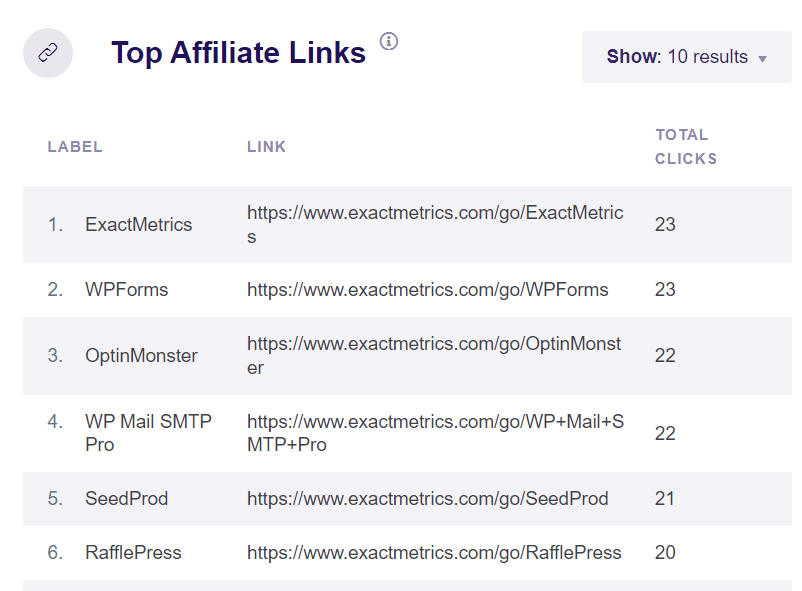
Read How to Track Affiliate Links in WordPress (the Easy Way) for more on affiliate link tracking.
Track File Downloads
Tracking file downloads on your site is crucial if you offer downloadable content to your visitors.
Fortunately, with ExactMetrics, monitoring these downloads is effortless and doesn’t require any coding.
Just install the plugin and specify the file types you wish to monitor (like pdf, zip, docx, xlsx, etc.). They will now be tracked automatically.

After setting up file tracking, you can see a report of all your downloads from your site. Simply head to ExactMetrics » Publishers » Overview.
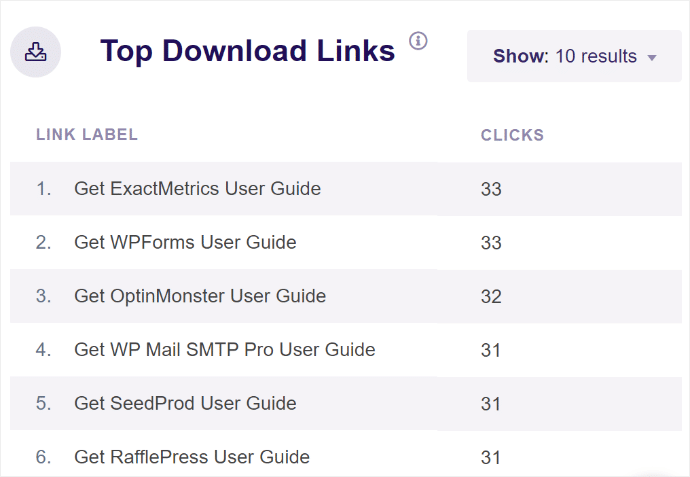
To view more data for your file download links in Google Analytics, click View All Download Links Report at the bottom of your ExactMetrics report.
For a full tutorial, check out How to Set Up Google Analytics File Download Tracking.
How to Track Custom Link Click Events in Google Analytics
Beyond the automated tracking of link and button clicks included above, ExactMetrics also simplifies the process of tracking custom links, like call-to-action buttons.
Before we delve into the manual approach, it’s essential to understand that it involves a bit of coding. Essentially, you’ll insert some additional text into the HTML of the link you wish to track as a custom click event.
Don’t worry, it’s very quick and easy!
Each link you track can contain details like the event category, action, and label. But if you prefer simplicity, just including a category is sufficient. The other details are optional!
This is what your tracked links should look like:
<a href=”https://www.yoursite.com” data-vars-ga-category=”Custom Category” data-vars-ga-action=”Custom Action” data-vars-ga-label=”Custom Label”>Example</a>
So, let’s say you’re tracking clicks on a header CTA to your signup page, then your link might look like this:
<a href=”https://www.yoursite.com” data-vars-ga-category=”CTA” data-vars-ga-action=”click” data-vars-ga-label=”header-signup-button”>Sign Up Now!</a>
Once the code is prepared, you can embed it on your CTA button. This will enable Google Analytics to begin tracking your custom link events.
For a complete guide on how to track links, read How to Track Link Clicks in Google Analytics and WordPress.
More Event Tracking with ExactMetrics
There’s more that ExactMetrics can track for you. Don’t miss:
- Media Tracking: Want to know how many people are watching your videos or how long they stick around? ExactMetrics can help you with media tracking, letting you know how engaging your media content is.
- Click-to-Call Links: If you have a phone number on your site, ExactMetrics can track how many visitors use the click-to-call feature. This is handy for understanding how many people are contacting you directly.
- Email Link Clicks: Do you have links in your emails or newsletters? ExactMetrics can also track when visitors click email links.
These features are just the tip of the iceberg when it comes to what ExactMetrics can do for your website. Try it out and discover even more ways to understand your audience!
How to Track Events in Google Analytics 4
You also have the option to track events directly in GA4. However, note that this method is more complex. If you are uncomfortable with coding, this way might not be the best for you.
To track events directly in GA4, first log into your Google Analytics 4 account.
Head down to the Admin section, found at the bottom left of your screen.
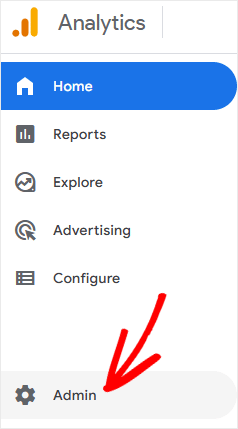
In the ‘Admin’ area, click on Data display and click Events from the list that appears. Click on Create event.
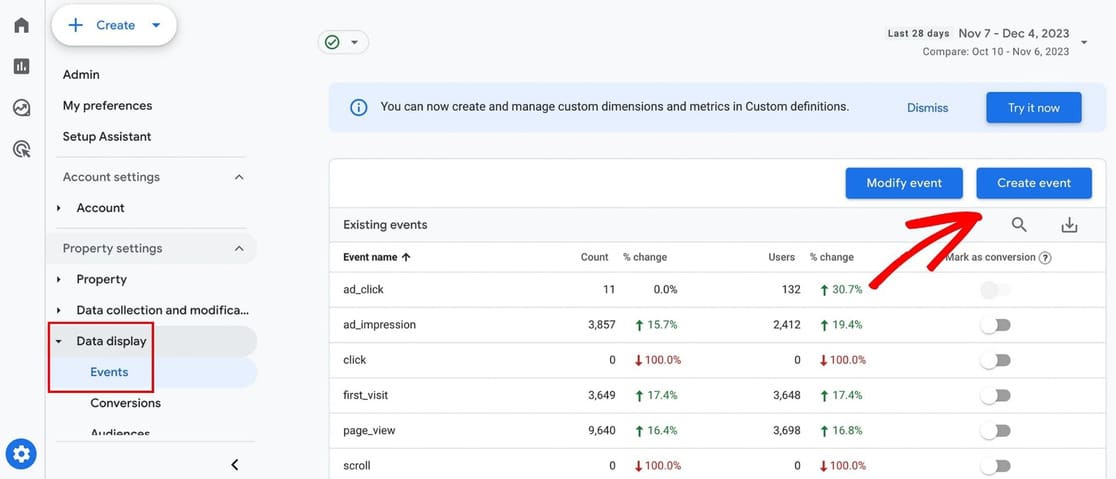
Now, you’re on your way to set up a brand new event. Think of a name that’s easy to remember and clearly describes your event. For instance, ‘signup_complete’ if you’re tracking when someone finishes a sign-up process.
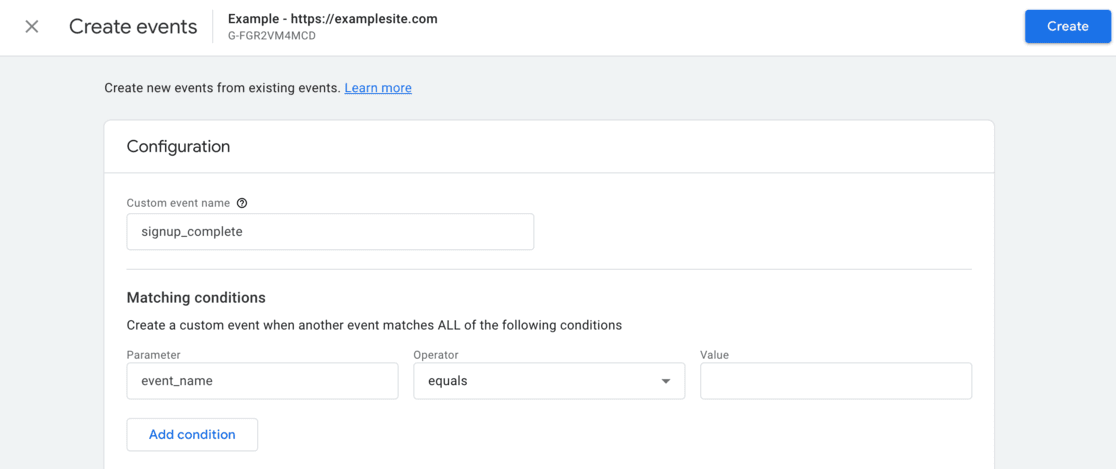
Now, you have to define the event. Here’s where you detail what makes this event. Say your goal is to track visits to a thank-you page. You’ll specify conditions like the page URL, perhaps ‘thank-you.html’, to indicate when this event is triggered.
After you’ve input all the details, click Create. Remember, it might take a little time for GA4 to start showing your new event in the tracking data.

Additionally, you have the option to create custom events and reports in GA4.
Head to Explore in the left navigation bar. From here you have to choose the type of custom report you wish to create.
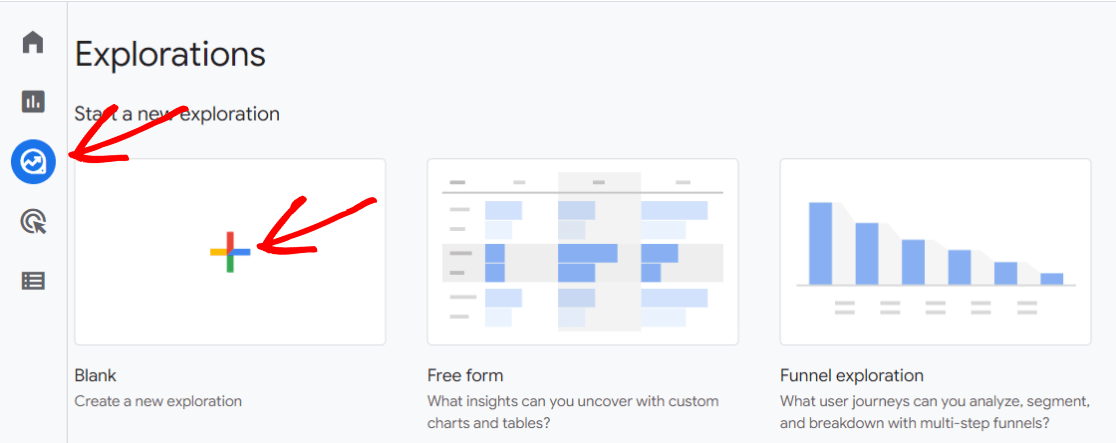
This part of GA4 allows you to create custom reports that suit your business needs. For more information on custom reports, check out How to Create Google Analytics 4 Custom Exploration Reports.
Understanding Event Parameters and Automatic Tracking in GA4
As we wrap up our exploration of GA4 Event Tracking, let’s dive into some bonus material that will elevate your analytics game.
In this section we will talk about the nuances of event parameters and the convenience of automatic tracking in GA4, giving you a fuller picture of how your website interacts with visitors.
Event Parameters in Google Analytics 4
When you track an event, you can also add extra details called ‘parameters.’ These are like little notes that give more info about each event.
For example, if you’re tracking page views, parameters can tell you the URL of the page where the visitor came from.
Google Analytics automatically sends some parameters with each event. These include things like:
- The session ID: this is a special number for each visitor’s session.
- The page location: showing the URL of the page they’re on.
- The page title: the name of the page.
- The page referrer: this tells you what page or site they came from before landing on your page.
Automatic Events in Google Analytics 4
When you set up GA4 on your website, it starts tracking some events all by itself, without you having to do anything! These include:
- First visit: The first time someone comes to your site.
- Page view: What page they’re looking at.
- Session start: When their visit (or session) starts.
- User engagement: If they’ve spent at least 10 seconds on your site.
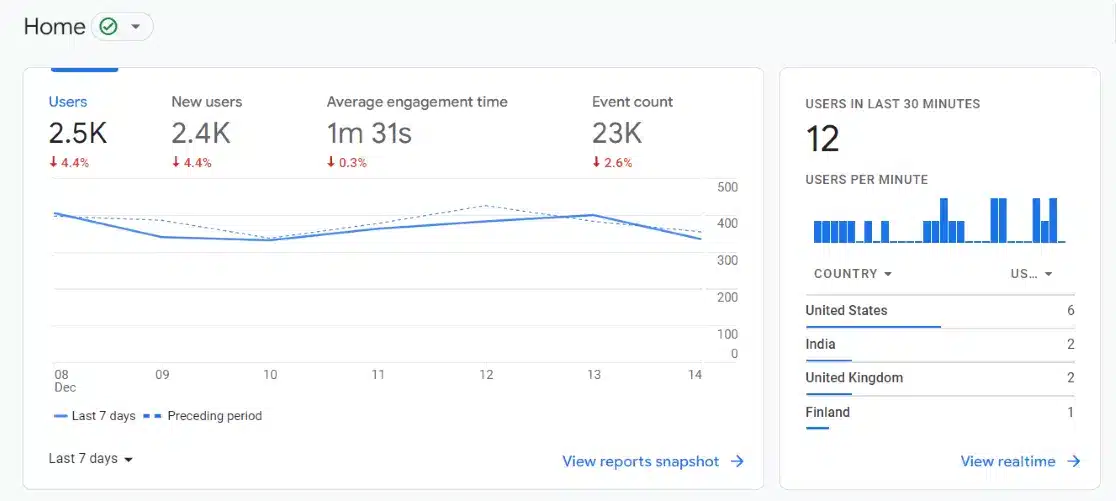
These automatic events are essential, and they help you understand how users interact with your site. You’ll see them in all GA4 properties, and they can’t be turned off.
Frequently Asked Questions
What is event tracking in Google Analytics?
Google Analytics event tracking is a feature that allows you to record specific user actions on your website, such as clicks on links, form submissions, or video plays.
What is event tracking used for?
Event tracking is used to monitor and analyze specific actions taken by users on your website, providing insights into user behavior and helping you evaluate the effectiveness of content and features.
How do I track events in Google Analytics?
To track events in Google Analytics, you can use the GA interface to set up event tracking codes or use tools like Google Tag Manager for a more streamlined process. For WordPress sites, the easiest is to use a plugin like ExactMetrics.
Which events can be tracked by Google?
Google Analytics can track a wide range of events, including page views, button clicks, form submissions, video plays, downloads, and custom events specific to your website’s needs.
We hope you found our guide on setting up Google Analytics 4 Event Tracking in WordPress helpful and easy to follow. For more insights, be sure to check out our Google Analytics Custom Dimensions: Complete Beginner’s Guide.
Haven’t started with ExactMetrics yet? Now’s the perfect time to dive in!
Also, don’t miss out on our latest tips and tutorials about Google Analytics – follow us on Twitter and Facebook.

